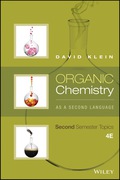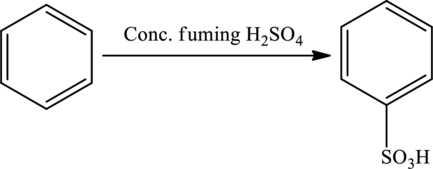
EBK ORGANIC CHEMISTRY AS A SECOND LANGU
4th Edition
ISBN: 9781119234722
Author: Klein
Publisher: JOHN WILEY+SONS,INC.-CONSIGNMENT
expand_more
expand_more
format_list_bulleted
Concept explainers
Question
Chapter 4.4, Problem 4.28P
Interpretation Introduction
Interpretation:
Mechanism for the sulfonation of benzene has to be drawn.
Concept Introduction:
In a reaction, fuming sulfuric acid is used to introduce sulfonic groups in a compound (sulfonation).

Expert Solution & Answer
Want to see the full answer?
Check out a sample textbook solution
Students have asked these similar questions
After running various experiments, you determine that the mechanism for the following reaction is bimolecular.
Br
+
OH
-
HO.
Using this information, draw the correct mechanism in the space below.
Br
+
Br
Add/Remove step
5
�
Click and drag to start
drawing a structure.
Problem 1
Consider the following reaction between nitrogen dioxide gas and carbon monoxide
gas
NO2 (g) + CO (g) → NO (g) + CO2 (g)
The experimentally determined rate law for this reaction is Rate = k [NO2]?.
A possible reaction mechanism involves two steps as shown below
NO2 (g) + NO2 (g) → NO3 (g) + NO (g)
Slow
NO3 (g) + CO (g) → NO2 (g) + CO2 (g)
Fast
After running various experiments, you determine that the mechanism for the following reaction is bimolecular.
Br.
+
Using this information, draw the correct mechanism in the space below.
Br
+ Br
Add/Remove step
X
G
Click and drag to start
drawing a structure.
Chapter 4 Solutions
EBK ORGANIC CHEMISTRY AS A SECOND LANGU
Ch. 4.1 - Consider the following reaction, in which an...Ch. 4.1 - Prob. 4.3PCh. 4.1 - Aromatic rings will also undergo iodination when...Ch. 4.2 - In each of the following cases, identify the...Ch. 4.2 - In each of the following cases, identify the...Ch. 4.2 - In each of the following cases, identify the...Ch. 4.3 - Prob. 4.10PCh. 4.3 - Prob. 4.11PCh. 4.3 - Prob. 4.12PCh. 4.3 - Prob. 4.13P
Ch. 4.3 - Prob. 4.14PCh. 4.3 - Predict the products of the following reaction.Ch. 4.3 - Prob. 4.16PCh. 4.3 - Prob. 4.17PCh. 4.4 - Identify the reagents you would use to achieve...Ch. 4.4 - Identify the reagents you would use to achieve...Ch. 4.4 - Identify the reagents you would use to achieve...Ch. 4.4 - Identify the reagents you would use to achieve...Ch. 4.4 - fill in the reagents you would use for the...Ch. 4.4 - fill in the reagents you would use for the...Ch. 4.4 - fill in the reagents you would use for the...Ch. 4.4 - fill in the reagents you would use for the...Ch. 4.4 - Prob. 4.27PCh. 4.4 - Prob. 4.28PCh. 4.4 - And now, for a challenging problem, try to draw...Ch. 4.6 - Prob. 4.31PCh. 4.6 - Prob. 4.32PCh. 4.6 - Prob. 4.33PCh. 4.6 - Prob. 4.34PCh. 4.6 - Prob. 4.35PCh. 4.6 - Prob. 4.36PCh. 4.6 - Prob. 4.37PCh. 4.6 - Prob. 4.40PCh. 4.6 - Prob. 4.41PCh. 4.6 - Predict the products for each of the following...Ch. 4.6 - Predict the products for each of the following...Ch. 4.6 - Predict the products for each of the following...Ch. 4.6 - Predict the products for each of the following...Ch. 4.6 - Prob. 4.47PCh. 4.6 - Prob. 4.48PCh. 4.6 - Prob. 4.49PCh. 4.6 - Prob. 4.50PCh. 4.6 - Prob. 4.51PCh. 4.6 - Prob. 4.52PCh. 4.6 - Prob. 4.53PCh. 4.6 - Prob. 4.54PCh. 4.6 - Prob. 4.55PCh. 4.6 - Prob. 4.56PCh. 4.7 - Prob. 4.58PCh. 4.7 - Prob. 4.59PCh. 4.7 - Prob. 4.60PCh. 4.7 - Prob. 4.61PCh. 4.7 - Prob. 4.62PCh. 4.7 - Prob. 4.63PCh. 4.7 - Prob. 4.64PCh. 4.7 - Prob. 4.65PCh. 4.7 - Prob. 4.66PCh. 4.7 - Prob. 4.67PCh. 4.7 - Can you explain why the following group is a...Ch. 4.7 - Prob. 4.70PCh. 4.7 - Prob. 4.71PCh. 4.7 - Prob. 4.72PCh. 4.7 - Prob. 4.73PCh. 4.7 - Prob. 4.74PCh. 4.7 - Prob. 4.76PCh. 4.7 - Prob. 4.77PCh. 4.7 - Prob. 4.78PCh. 4.7 - Prob. 4.79PCh. 4.8 - Propose an efficient synthesis for each of the...Ch. 4.8 - Propose an efficient synthesis for each of the...Ch. 4.8 - Propose an efficient synthesis for each of the...Ch. 4.8 - Propose an efficient synthesis for each of the...Ch. 4.8 - Propose an efficient synthesis for each of the...Ch. 4.8 - Prob. 4.87PCh. 4.8 - Prob. 4.88PCh. 4.8 - Prob. 4.89PCh. 4.8 - Prob. 4.90PCh. 4.8 - Prob. 4.91PCh. 4.8 - Prob. 4.92PCh. 4.9 - Prob. 4.94PCh. 4.9 - Prob. 4.95PCh. 4.9 - Prob. 4.96PCh. 4.9 - Prob. 4.97PCh. 4.9 - Prob. 4.98PCh. 4.9 - Prob. 4.99PCh. 4.9 - Prob. 4.100PCh. 4.9 - Prob. 4.101PCh. 4.9 - Prob. 4.102P
Knowledge Booster
Learn more about
Need a deep-dive on the concept behind this application? Look no further. Learn more about this topic, chemistry and related others by exploring similar questions and additional content below.Similar questions
- Fill in the box with the major organic product of the following reaction mechanism. NaOH Draw the resonance structures of the product from the previous question. Draw in the curved arrow for the deprotonation of tert-butyl alcohol. to H K (metal) toarrow_forwardI want mechanism for this reaction including electron movements.arrow_forwardAfter running various experiments, you determine that the rate law for the following reaction has a first-order dependence on the concentration of the alkyl halide, and doesn't depend on the concentration of the other reactant at all. Br + H₂O + H30* + Br Using this information, draw the correct mechanism in the space below. Br Add/Remove step X G Click and drag to start drawing a structure.arrow_forward
- Show all the processes in the mechanism of the reaction.arrow_forwardFor each of the four reaction mechanisms (SN1, SN2, E1, E2) pick one of each to combine such that they are most likely to undergo reaction by that particular mechanism. You may also make a comment about temperature. Do NOT use anything more than once. You want to pick you combinations so that the indicated mechanism is most likely to occur-there will not be any “no reactions”. Where the mechanism is indicated draw the full arrow pushing mechanism and products of each reaction. If the indicated mechanism will form more than one isomer you should draw structures of all isomers which may be formed by the indicated mechanism but you do not need to draw the full mechanism for each. Pick any one to do the mechanism. You do NOT need to draw minor products formed yet. On the reactant molecules shown adding R and S to each chirality center.arrow_forwardComplete the electron-pushing mechanism for the reaction of the y-hydroxyaldehyde in hydrochloric acid by adding any missing atoms, bonds, charges, nonbonding electrons, and curved arrows. Note the use of a generic alcohol representing another alcohol molecule in solution. Step 1: draw curved arrows. Step 2: complete the structure and add curved arrows. Select Draw Rings Groups More Erase Select Draw Rings Groups More Erase R -0 : H. | H H 1Larrow_forward
- Your answer is incorrect. Predict the relative rates of these reactions. That is, select 1 next to the reaction with the fastest rate, 2 next to the reaction with the next fastest rate, and so on. Note for advanced students: you may assume these reactions all take place in a polar aprotic solvent, like DMSO. Incorrect Your answer is incorrect. Predict the relative rates of these reactions. That is, select I next to the reaction with the fastest rate, 2 next to the reaction with the next fastest rate, and so on. Note for advanced students: you may assume these reactions all take place in a polar aprotic solvent, like DMSO. Reaction Relative Rate G + H₂O - OH₂ 2 Br + H₂S - + Br 3 + H₂S SHI + ci I (fastest) Br + H₂O OM₂ + Br 4 (slowest)arrow_forwardAlthough you may not have seen the reaction highlighted in green before, it uses similar chemical concepts you have seen in other reaction mechanisms. Draw the mechanism.arrow_forwardDetermine the mechanism and product for the given reaction by adding atoms, bonds, nonbonding electron pairs, and curved arrows. Acid and water are added in the second step. CH₂CH₂MgBr 2 Step 1: Add curved arrows. * MB Br → product Et₂ O Step 2: Aqueous workup. Complete the intermediate, then add curved arrows for the workup step. H : CLT: Mg Brarrow_forward
arrow_back_ios
SEE MORE QUESTIONS
arrow_forward_ios
Recommended textbooks for you
 ChemistryChemistryISBN:9781305957404Author:Steven S. Zumdahl, Susan A. Zumdahl, Donald J. DeCostePublisher:Cengage Learning
ChemistryChemistryISBN:9781305957404Author:Steven S. Zumdahl, Susan A. Zumdahl, Donald J. DeCostePublisher:Cengage Learning ChemistryChemistryISBN:9781259911156Author:Raymond Chang Dr., Jason Overby ProfessorPublisher:McGraw-Hill Education
ChemistryChemistryISBN:9781259911156Author:Raymond Chang Dr., Jason Overby ProfessorPublisher:McGraw-Hill Education Principles of Instrumental AnalysisChemistryISBN:9781305577213Author:Douglas A. Skoog, F. James Holler, Stanley R. CrouchPublisher:Cengage Learning
Principles of Instrumental AnalysisChemistryISBN:9781305577213Author:Douglas A. Skoog, F. James Holler, Stanley R. CrouchPublisher:Cengage Learning Organic ChemistryChemistryISBN:9780078021558Author:Janice Gorzynski Smith Dr.Publisher:McGraw-Hill Education
Organic ChemistryChemistryISBN:9780078021558Author:Janice Gorzynski Smith Dr.Publisher:McGraw-Hill Education Chemistry: Principles and ReactionsChemistryISBN:9781305079373Author:William L. Masterton, Cecile N. HurleyPublisher:Cengage Learning
Chemistry: Principles and ReactionsChemistryISBN:9781305079373Author:William L. Masterton, Cecile N. HurleyPublisher:Cengage Learning Elementary Principles of Chemical Processes, Bind...ChemistryISBN:9781118431221Author:Richard M. Felder, Ronald W. Rousseau, Lisa G. BullardPublisher:WILEY
Elementary Principles of Chemical Processes, Bind...ChemistryISBN:9781118431221Author:Richard M. Felder, Ronald W. Rousseau, Lisa G. BullardPublisher:WILEY

Chemistry
Chemistry
ISBN:9781305957404
Author:Steven S. Zumdahl, Susan A. Zumdahl, Donald J. DeCoste
Publisher:Cengage Learning

Chemistry
Chemistry
ISBN:9781259911156
Author:Raymond Chang Dr., Jason Overby Professor
Publisher:McGraw-Hill Education

Principles of Instrumental Analysis
Chemistry
ISBN:9781305577213
Author:Douglas A. Skoog, F. James Holler, Stanley R. Crouch
Publisher:Cengage Learning

Organic Chemistry
Chemistry
ISBN:9780078021558
Author:Janice Gorzynski Smith Dr.
Publisher:McGraw-Hill Education

Chemistry: Principles and Reactions
Chemistry
ISBN:9781305079373
Author:William L. Masterton, Cecile N. Hurley
Publisher:Cengage Learning

Elementary Principles of Chemical Processes, Bind...
Chemistry
ISBN:9781118431221
Author:Richard M. Felder, Ronald W. Rousseau, Lisa G. Bullard
Publisher:WILEY